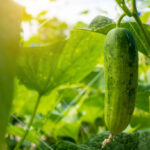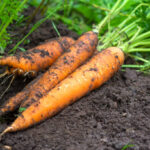
Welcome to our comprehensive guide on the best way to plant and grow delicious asparagus in your very own garden or backyard. Asparagus is gaining popularity not only in markets and grocery stores but also as a vegetable of choice for home gardeners. There’s simply no comparison between the flavor and crispness of fresh-picked asparagus spears straight from your garden and the ones you find at the supermarket.
Planting your own crop of asparagus offers numerous benefits. Not only is it easy to grow and maintain, but it also doesn’t require a large amount of space. The best part is that asparagus is a perennial crop, which means that with just a single planting, you can enjoy bountiful harvests for years to come.
The Benefits of Growing Your Own Asparagus

The unmatched taste of freshly harvested asparagus from your own backyard is reason enough to start growing it. However, there are many other compelling reasons to include asparagus in your garden. Here are a few:
- Nutritional Value: Asparagus is one of the healthiest vegetables you can grow. It’s packed with essential nutrients and vitamins, low in calories, and can contribute to lower blood pressure and improved digestion.
- Long-Term Harvests: A well-established planting of asparagus crowns can keep producing for 20 years or even longer. Imagine the joy of harvesting your own asparagus year after year without the need for replanting!
Now, let’s dive into the step-by-step process of planting and growing asparagus to ensure your success.
Selecting the Perfect Growing Location
Choosing the right location for your asparagus bed is crucial for long-term success. Asparagus is a perennial crop, meaning it will grow in the same spot for many years. Here’s what you need to consider when selecting a growing location:
- Sunlight Requirements: Asparagus thrives in full sun. Ensure that the chosen area receives at least six to eight hours of direct sunlight each day. Although partial shade is tolerated, optimal growth and yield are achieved in sunny locations.
- Future Shade: Anticipate the growth of nearby trees or shrubs that could cast unwanted shade on your asparagus bed. As the trees or shrubs grow, they may reduce the sunlight your asparagus receives, affecting its productivity.
Preparing the Soil for Asparagus Planting

Now that you have chosen the perfect location, it’s time to prepare the soil for your asparagus plants. Asparagus grows best in fertile, loose, and well-draining soil. Follow these steps to ensure your soil is in top condition:
- Amending the Soil: Prior to planting, enrich the soil with nutrients by incorporating a generous amount of compost. Compost improves the soil’s structure and humus levels, promoting healthy root and spear growth. A soil mix of 1/3 compost to 2/3 existing soil is ideal.
- Improving Drainage: If your soil is heavy or clay-like, consider adding some sand to improve drainage. Good drainage is essential for the health and vigor of asparagus plants.
- Planting Depth: Asparagus crowns should be planted around 6 inches deep in the soil. Make sure the roots are spread out over the soil, and then cover them with about two inches of soil initially. Leave space in the trench to gradually fill it in over time as the plants grow.
Choosing Between Asparagus Crowns and Seeds
When it comes to planting asparagus, you have the choice between using crowns or seeds. While growing from seeds is an option, it requires more time and patience. Here’s why planting crowns is generally the preferred method:
- Ease of Planting: Asparagus crowns are easier to plant compared to seeds. They are the roots of 1 to 2 year-old asparagus plants and allow for earlier harvests.
- Weed Management: Seeds require diligent weed control during germination and early growth stages. Crowns, on the other hand, have a head start and are easier to manage when it comes to weed control.
For a faster and more successful asparagus planting, we recommend using crowns. Male varieties are usually preferred due to their larger size and higher spear production levels.
Planting Asparagus Crowns for Optimal Growth

Now that you’ve chosen the right asparagus crowns, it’s time to plant them properly to ensure vigorous growth. Follow these steps to achieve the best results:
- The Trench Method: Dig a trench approximately 6 inches deep and 8 inches wide in the soil. Place the asparagus crowns at the bottom of the trench, ensuring that the roots are spread out over the soil.
- Watering the Roots: Once the crowns are in place, water the roots thoroughly. This helps settle the soil and ensures good root-to-soil contact.
- Partial Covering: Cover the crowns with about two inches of soil. There’s no need to fill up the entire trench at this stage. Leave space to gradually fill in the trench as the asparagus grows.
- Spacing: Maintain a spacing of approximately 18 inches between each crown and 12 inches between rows. This allows ample room for the plants to grow and ensures good air circulation.
First Year Growth and Maintenance
Asparagus requires patience, especially during the first year of growth. While it can be tempting to harvest spears in the first season, it’s crucial to resist the temptation. Here’s what you need to know:
- No Harvest in Year One: Allow your asparagus crop to grow without cutting or harvesting during the first year. This allows the crowns to establish themselves and develop strong root systems.
- Energy Storage: By letting the spears grow and mature without harvesting, the asparagus plant can store energy in its roots. This energy will support future growth and ensure larger and more productive harvests in the years to come.
- Fall Maintenance: Once the foliage dies off in the fall, cut it back to the ground. This prepares the asparagus plants for the next growing season.
- Year Two and Beyond: In the second year, you can begin harvesting spears early. After an early harvest, allow the plants to grow to full maturity. Starting from the third year, you can harvest asparagus normally. However, always let the plants grow after harvesting until the fall season.
Mulching for Weed Control and Moisture Retention
Maintaining weed-free asparagus beds is essential for maximizing productivity. Mulching is an effective method to suppress weeds and retain moisture. Here’s how to do it:
- Choose the Right Mulch: Use a thick layer of straw or shredded leaves to mulch your asparagus beds. A four-inch layer is typically sufficient to control weeds and keep the soil moisture levels optimal.
- Mulch Thickness: Add a few more inches of mulch in late fall to insulate and protect the crowns during the winter months.
Fertilizing for Strong Asparagus Growth

To keep your asparagus plants healthy and productive, proper fertilization is essential. Asparagus is a perennial crop that benefits from periodic nutrient replenishment. Here’s what you need to know:
- Timing: Fertilize your asparagus bed twice a year for optimal results. Apply fertilizer in late summer/early fall and again in early spring, before the spears emerge.
2Organic Fertilizer: Consider using an all-purpose organic granular fertilizer to provide essential nutrients to your asparagus plants. Apply the fertilizer according to the manufacturer’s instructions, ensuring even distribution around the plants.
- Compost Application: Another effective method to enhance soil fertility is by applying a top coat of compost. Pull back the mulch and spread a few inches of compost around the base of each plant. This can be done in both early spring and late summer.
By fertilizing your asparagus bed regularly, you replenish the nutrients that the plants use up over time, ensuring continuous growth and abundant spear production.
Conclusion
Congratulations! You are now equipped with the knowledge and insights to plant and grow your own flavorful and nutritious asparagus crop. Remember to choose a sunny location, prepare the soil with ample organic matter, and opt for crowns over seeds for a faster and more successful harvest. Maintain proper spacing, resist harvesting in the first year, and mulch your asparagus bed to control weeds and retain moisture. Lastly, fertilize your plants twice a year to promote robust growth.
Enjoy the satisfaction of harvesting fresh asparagus spears from your own garden for years to come. Whether you savor them raw, lightly steamed, or in your favorite recipes, the flavors and nutritional benefits will be worth the effort. Happy gardening!






